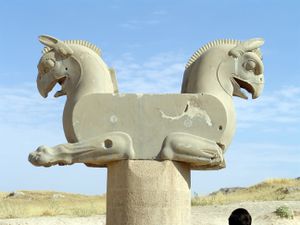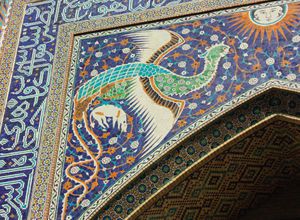「フマ」の版間の差分
(→関連項目) |
|||
| (同じ利用者による、間の72版が非表示) | |||
| 1行目: | 1行目: | ||
| − | '''フマ''' | + | [[File:Homa.JPG|thumb|グリフィン(Griffin)のような柱頭像、イラン、ペルセポリス紀元前500年頃のもの。イランでは、この柱の像はフマ鳥だと解釈されている。<ref name="BM">Curtis , John , Tallis , Nigel , Forgotten Empire, the World of Ancient Persia , London , British Museum Press , 2005 , isbn:978-0-7141-1157-5</ref>]] |
| + | '''フマ'''(Huma、ペルシア語:هما、発音:Homer、アヴェスター語:Homāio)はペルシア神話上の伝説の鳥であり、<ref>MacKenzie, D. N. ,A concise Pahlavi Dictionary, 2005, Routledge Curzon, London & New York, isbn:0-19-713559-5</ref><ref>Mo'in, M., Mohammad Moin, A Persian Dictionary. Six Volumes, 1992, Amir Kabir Publications, Tehran, isb:1-56859-031-8</ref>スーフィーの詩やディヴァン (詩集)で共通のモチーフとして使い続けられている。ペルシアのフェニックスと呼ばれることもあるが、実際には中国の吉兆の鳥、鳳凰と似ている部分が多い。例えば、雌雄を兼ね備えているところがある。だが、フマの場合は半分が雄で、もう半分が雌である。 | ||
| − | + | 様々な伝説があるが、共通しているのは、この鳥は地上に降り立つことはなく、生涯、目に見えないほど高いところを飛んで生活すると言われていることである。フマはその影の落ちかかった者すべてに恩恵を与え、ほんのわずかな間でも、その頭に乗ることのできた幸運のものは、王になることが期待できる。 | |
| − | = | + | この名前には多くの民間解釈があり、中でもスーフィーの師イナヤット・カーンは「Humaという言葉の中でhuは精神を表し、mahという言葉はアラビア語で水を意味する『Maʼa』 ماءに由来する」と仮定している<ref name="Mysticism of Music">http://wahiduddin.net/mv2/II/II_8.htm , The Mysticism of Music, Sound and Word , Abstract Sound , Khan , Inayat , 1923 , wahiduddin.net</ref>。 |
| − | |||
| + | == 神話と伝説 == | ||
| + | [[File:Nadir Divan-begi Madrasa.jpg|thumb|300px|ウズベキスタン、ブハラにあるナディール・ディバンベギ・マドラサの門(the portal of Nadir Divan-Begi Madrasa)に描かれた神話上の鳥「フマ」のモザイク画]] | ||
| + | フマという鳥は、一生休むことなく、目に見えないほど高いところを飛び、地上に降り立つこともないと言われている(脚がないという伝説もある)<ref name="Nile">Nile, Green, Ostrich Eggs and Peacock Feathers: Sacred Objects as Cultural Exchange between Christianity and Islam, Al Masaq: Islam and the Medieval Mediterranean, 18, 1, <!--March-->2006, pages:27–78, doi:10.1080/09503110500222328.</ref>。 | ||
| − | + | フマの神話のいくつかのバリエーションでは、この鳥は不死鳥のようであり、数百年ごとに火で自らを焼き尽くし、灰の中から新たに立ち上がる、と言われている。フマという鳥は、一体の中に雄と雌の性質を持ち(中国の鳳凰を思わせる)、それぞれの性質が片翼と片足を持っていると言われている。フマは慈悲深く、その影(または触れること)が吉とされることから「幸運の鳥」<ref name="divan">http://turkoloji.cu.edu.tr/ESKI%20TURK%20%20EDEBIYATI/batislam.pdf , H. Dilek Batîslam , Mythological Birds of the Classical Ottoman Poetry: Huma, Anka and Simurg. , Türk Kültürü İncelemeleri Dergisi,İstanbul 2002, 185–208 , 3 August 2009 , language=tr</ref>とされている。 | |
| − | |||
| − | |||
| − | |||
| − | |||
| − | |||
| − | |||
| − | |||
| − | |||
| − | |||
| − | |||
| − | + | スーフィーの伝統では、フマを捕まえることは想像を超えることだが、その姿を垣間見ること、あるいはその影を見ることは、その人の残りの人生を幸せにすることになるとされている。また、フーマは生きていては捕まえられないと信じられており、フーマを殺した者は40日後に死ぬと言われている<ref name="divan"/>。 | |
| − | + | オスマン帝国の詩では、この鳥はしばしば「極楽鳥」と呼ばれている<ref name="divan"/><ref>''cf''. Andrews, Walter, Kalpakli, Mehmet, The Age of Beloveds, 2005, Duke University Press, pages:341–342.</ref>。パラディサス科の種に関する初期のヨーロッパの記述では、この鳥には翼や脚がなく、鳥は生涯空中にいるものと想定されていた。 | |
| − | |||
| − | |||
| − | |||
| − | + | ペルシャ文学におけるスーフィー作品の代表格であるニシャプールのファリードゥッディーン・アッタール(Attar of Nishapur)の寓話的名作『鳥の言葉(The Conference of the Birds)』では、フマ鳥が旅をすることを拒む弟子のように描かれている。なぜならそのように旅をすれば、飛んでいった相手に王権を与える特権が損なわれるからだ。イランの文献では、このフマ鳥の'''王権授与'''の性質は、イスラーム以前の君主に対しても同じようにみなされ、アラブ人の隠喩であるカラスと対をなすものとみなされている<ref>Pourshariati, Parvaneh, Local Historiography in Early Medieval Iran and the Tārīkh-i Bayhaq, Iranian Studies, 33, 1/2, year:2000, pages:133–164, doi:10.1080/00210860008701979, p. 151.</ref>。フマの伝説はスーフィー派以外の文芸にも登場する<ref>''cf''. <!-- "Balwant Singh on A Terrace Overlooking a River"-->Goswamy, B. N., Nainsukh of Guler: A Great Indian Painter from a Small Hill-State, Artibus Asiae, Supplementum, 41, 1997, pages:5–304, p. 118.</ref>。 | |
| − | + | フマの王位授与機能は、ムガル帝国時代のインドの物語にも登場し、フマ鳥が人の頭や肩に影を落とす(あるいは降り立つ)と、王位を授与する(あるいは予言する)とされた。そのため、王のターバンを飾る羽は、フマの羽毛だと言われていた<ref name="schimmel">Schimmel, Annemarie, Attwood, Corinne, Waghmar, Burzine, The Empire of the Great Mughals: History, Art and Culture, Reaktion, 2004, page:30.</ref>。 | |
| − | + | スーフィーの師イナヤット・カーン<ref>5 July 1882 – 5 February 1927</ref>は、王位授与伝説に次のような霊的な説明を加えている。「その本当の意味は、人の思考がすべての限界を超えて進化したとき、人は王となる、ということである。『最も高い次元のもの(the Most High)』を王としてしか表現できないのが、言葉の限界なのだ<ref name="Mysticism of Music"/>。」 | |
| − | + | トルコの民俗文学では、フマ鳥は手の届かない高貴な存在の象徴とされている<ref name="hbv">https://web.archive.org/web/20140308163058/http://www.hbvdergisi.gazi.edu.tr/index.php/TKHBVD/article/view/572/562 , 8 March 2014</ref>。フマについては、シンド語文学<ref>シンド語文学(Sindhi: سنڌي ادب)は、パキスタンのシンド州にあるシンド語系の文学で、詩と散文から構成されている。</ref>にもいくつか登場し、ディヴァン (詩集)の伝統と同様、大きな幸運をもたらすものとして描かれている。グル・ゴービンド・シング<ref>1666年12月22日 - 1708年10月7日。シク教の第10代グル(尊師)。</ref>のZafarnamaでは、ムガル帝国皇帝アウラングゼーブ(Aurangzeb)<ref>1618年11月3日 - 1707年3月3日。北インド、ムガル帝国の領土を最大にした第6代皇帝。</ref>に宛てた手紙の中で、フマを「強大で吉兆な鳥」と述べている。 | |
| − | + | == フマが登場する作品等 == | |
| − | + | [[File:Homa Persepolis Iran.JPG|thumbnail|グリフィンを模した首都像、イラン、ペルセポリスの紀元前500年頃のもの。この柱の像は一般的にフマ鳥だと解釈されている<ref name="BM" />]] | |
| − | + | * 大英博物館のカタログには、ペルセポリスのグリフィン型柱頭の写真に「グリフィン(現地では「フマ(homa)鳥」と呼ばれる)の形をした柱頭」とキャプションがつけられている。<ref name="BM" /> | |
| + | *ペルシャ語で「イラン国営航空」の頭文字をとって「HOMA」といい、航空会社のエンブレムにはフマ鳥がデザインされている。 | ||
| + | * ハーマン・メルヴィル(Herman Melville)<ref>1819年8月1日 - 1891年9月28日。「白鯨」の作者。</ref>は『白鯨(Moby-Dick)』の中で、この鳥について簡単に触れている。「尾(The Tail)」と題された章の冒頭で、語り手は "決して降り立つことのない鳥 "について話している。 | ||
| + | * イヴァン・ブーニン(Ivan Bunin)<ref>1870年10月22日(ユリウス暦10月10日) - 1953年11月8日。ロシア帝国出身の作家。</ref>の短編集『鳥の影(Bird's Shadow)』のタイトルにもなっている。 | ||
| + | * ウォン・カーウァイ監督<ref>1958年7月17日 -。香港の映画監督。</ref>の映画「欲望の翼(Days of Being Wild)」やテネシー・ウィリアムズ<ref>1911年3月26日 - 1983年2月25日。アメリカの劇作家</ref>の戯曲「オルフェウス降臨(Orpheus Descending)」でも言及されている。 | ||
| + | * 文学作品「ドラゴンランス(Dragonlance)」では、クリンの偉大な英雄、ヒューマ・ドラゴンベイン(Huma Dragonbane)をフマにちなんで命名した。 | ||
| + | * エレノア・F・ヘリン(Eleanor F. Helin)<ref>1932年11月19日 - 2009年1月25日。アメリカの女性天文学者。</ref>によって発見された小惑星3988フマは、フマ鳥にちなんで名づけられた。小惑星の名前は、SGACの''Name An Asteroid Campaign''によって提案された。<ref name="MPC-Huma">3988 Huma (1986 LA) , Minor Planet Center , http://www.minorplanetcenter.net/db_search/show_object?object_id=3988 , 27 September 2016</ref> | ||
| − | + | == フマ的な鳥が登場する民話 == | |
| + | * [http://bellis.sakura.ne.jp/k/tegalog.cgi?postid=97 動物のことばがわかる男]:鳩(レートロマン) | ||
| + | * [http://bellis.sakura.ne.jp/k/tegalog.cgi?postid=204 ユシィフとズライカ]:鷹(中国・パミール高原) | ||
| − | == | + | == 関連項目 == |
| − | [[ | + | * [[ベンヌ]] |
| + | * [[フェニックス]] | ||
| + | * [[シームルグ]] | ||
| − | + | == 参考文献 == | |
| − | * | + | * Wikipedia:[https://ja.wikipedia.org/wiki/%E3%83%95%E3%83%9E フマ](最終閲覧日:22-03-21) |
| − | + | * Wikipedia:[https://en.wikipedia.org/wiki/Huma_bird Huma bird](最終閲覧日:22-03-26) | |
| − | + | ** Saccone, Carlo, Humā, https://referenceworks.brillonline.com/entries/encyclopaedia-of-islam-3/huma-COM_30551?s.num=22&s.f.s2_parent=s.f.book.encyclopaedia-of-islam-3&s.start=20&s.q=Iranian , 2018 | |
| − | |||
| − | |||
| − | * | ||
| − | |||
| − | |||
| − | |||
| − | |||
| − | |||
| − | |||
| − | |||
| − | |||
| − | * | ||
| − | * | ||
| − | |||
| − | |||
| − | |||
| − | |||
== 参照 == | == 参照 == | ||
{{デフォルトソート:ふま}} | {{デフォルトソート:ふま}} | ||
| + | [[Category:イラン神話]] | ||
[[Category:鳥]] | [[Category:鳥]] | ||
| − | [[Category: | + | [[Category:不死鳥]] |
| − | [[Category: | + | [[Category:王権神授]] |
| + | [[Category:瑞鳥]] | ||
2022年4月5日 (火) 00:20時点における最新版

フマ(Huma、ペルシア語:هما、発音:Homer、アヴェスター語:Homāio)はペルシア神話上の伝説の鳥であり、[2][3]スーフィーの詩やディヴァン (詩集)で共通のモチーフとして使い続けられている。ペルシアのフェニックスと呼ばれることもあるが、実際には中国の吉兆の鳥、鳳凰と似ている部分が多い。例えば、雌雄を兼ね備えているところがある。だが、フマの場合は半分が雄で、もう半分が雌である。
様々な伝説があるが、共通しているのは、この鳥は地上に降り立つことはなく、生涯、目に見えないほど高いところを飛んで生活すると言われていることである。フマはその影の落ちかかった者すべてに恩恵を与え、ほんのわずかな間でも、その頭に乗ることのできた幸運のものは、王になることが期待できる。
この名前には多くの民間解釈があり、中でもスーフィーの師イナヤット・カーンは「Humaという言葉の中でhuは精神を表し、mahという言葉はアラビア語で水を意味する『Maʼa』 ماءに由来する」と仮定している[4]。
神話と伝説[編集]
フマという鳥は、一生休むことなく、目に見えないほど高いところを飛び、地上に降り立つこともないと言われている(脚がないという伝説もある)[5]。
フマの神話のいくつかのバリエーションでは、この鳥は不死鳥のようであり、数百年ごとに火で自らを焼き尽くし、灰の中から新たに立ち上がる、と言われている。フマという鳥は、一体の中に雄と雌の性質を持ち(中国の鳳凰を思わせる)、それぞれの性質が片翼と片足を持っていると言われている。フマは慈悲深く、その影(または触れること)が吉とされることから「幸運の鳥」[6]とされている。
スーフィーの伝統では、フマを捕まえることは想像を超えることだが、その姿を垣間見ること、あるいはその影を見ることは、その人の残りの人生を幸せにすることになるとされている。また、フーマは生きていては捕まえられないと信じられており、フーマを殺した者は40日後に死ぬと言われている[6]。
オスマン帝国の詩では、この鳥はしばしば「極楽鳥」と呼ばれている[6][7]。パラディサス科の種に関する初期のヨーロッパの記述では、この鳥には翼や脚がなく、鳥は生涯空中にいるものと想定されていた。
ペルシャ文学におけるスーフィー作品の代表格であるニシャプールのファリードゥッディーン・アッタール(Attar of Nishapur)の寓話的名作『鳥の言葉(The Conference of the Birds)』では、フマ鳥が旅をすることを拒む弟子のように描かれている。なぜならそのように旅をすれば、飛んでいった相手に王権を与える特権が損なわれるからだ。イランの文献では、このフマ鳥の王権授与の性質は、イスラーム以前の君主に対しても同じようにみなされ、アラブ人の隠喩であるカラスと対をなすものとみなされている[8]。フマの伝説はスーフィー派以外の文芸にも登場する[9]。
フマの王位授与機能は、ムガル帝国時代のインドの物語にも登場し、フマ鳥が人の頭や肩に影を落とす(あるいは降り立つ)と、王位を授与する(あるいは予言する)とされた。そのため、王のターバンを飾る羽は、フマの羽毛だと言われていた[10]。
スーフィーの師イナヤット・カーン[11]は、王位授与伝説に次のような霊的な説明を加えている。「その本当の意味は、人の思考がすべての限界を超えて進化したとき、人は王となる、ということである。『最も高い次元のもの(the Most High)』を王としてしか表現できないのが、言葉の限界なのだ[4]。」
トルコの民俗文学では、フマ鳥は手の届かない高貴な存在の象徴とされている[12]。フマについては、シンド語文学[13]にもいくつか登場し、ディヴァン (詩集)の伝統と同様、大きな幸運をもたらすものとして描かれている。グル・ゴービンド・シング[14]のZafarnamaでは、ムガル帝国皇帝アウラングゼーブ(Aurangzeb)[15]に宛てた手紙の中で、フマを「強大で吉兆な鳥」と述べている。
フマが登場する作品等[編集]

- 大英博物館のカタログには、ペルセポリスのグリフィン型柱頭の写真に「グリフィン(現地では「フマ(homa)鳥」と呼ばれる)の形をした柱頭」とキャプションがつけられている。[1]
- ペルシャ語で「イラン国営航空」の頭文字をとって「HOMA」といい、航空会社のエンブレムにはフマ鳥がデザインされている。
- ハーマン・メルヴィル(Herman Melville)[16]は『白鯨(Moby-Dick)』の中で、この鳥について簡単に触れている。「尾(The Tail)」と題された章の冒頭で、語り手は "決して降り立つことのない鳥 "について話している。
- イヴァン・ブーニン(Ivan Bunin)[17]の短編集『鳥の影(Bird's Shadow)』のタイトルにもなっている。
- ウォン・カーウァイ監督[18]の映画「欲望の翼(Days of Being Wild)」やテネシー・ウィリアムズ[19]の戯曲「オルフェウス降臨(Orpheus Descending)」でも言及されている。
- 文学作品「ドラゴンランス(Dragonlance)」では、クリンの偉大な英雄、ヒューマ・ドラゴンベイン(Huma Dragonbane)をフマにちなんで命名した。
- エレノア・F・ヘリン(Eleanor F. Helin)[20]によって発見された小惑星3988フマは、フマ鳥にちなんで名づけられた。小惑星の名前は、SGACのName An Asteroid Campaignによって提案された。[21]
フマ的な鳥が登場する民話[編集]
- 動物のことばがわかる男:鳩(レートロマン)
- ユシィフとズライカ:鷹(中国・パミール高原)
関連項目[編集]
参考文献[編集]
参照[編集]
- ↑ 1.0 1.1 1.2 Curtis , John , Tallis , Nigel , Forgotten Empire, the World of Ancient Persia , London , British Museum Press , 2005 , isbn:978-0-7141-1157-5
- ↑ MacKenzie, D. N. ,A concise Pahlavi Dictionary, 2005, Routledge Curzon, London & New York, isbn:0-19-713559-5
- ↑ Mo'in, M., Mohammad Moin, A Persian Dictionary. Six Volumes, 1992, Amir Kabir Publications, Tehran, isb:1-56859-031-8
- ↑ 4.0 4.1 http://wahiduddin.net/mv2/II/II_8.htm , The Mysticism of Music, Sound and Word , Abstract Sound , Khan , Inayat , 1923 , wahiduddin.net
- ↑ Nile, Green, Ostrich Eggs and Peacock Feathers: Sacred Objects as Cultural Exchange between Christianity and Islam, Al Masaq: Islam and the Medieval Mediterranean, 18, 1, 2006, pages:27–78, doi:10.1080/09503110500222328.
- ↑ 6.0 6.1 6.2 http://turkoloji.cu.edu.tr/ESKI%20TURK%20%20EDEBIYATI/batislam.pdf , H. Dilek Batîslam , Mythological Birds of the Classical Ottoman Poetry: Huma, Anka and Simurg. , Türk Kültürü İncelemeleri Dergisi,İstanbul 2002, 185–208 , 3 August 2009 , language=tr
- ↑ cf. Andrews, Walter, Kalpakli, Mehmet, The Age of Beloveds, 2005, Duke University Press, pages:341–342.
- ↑ Pourshariati, Parvaneh, Local Historiography in Early Medieval Iran and the Tārīkh-i Bayhaq, Iranian Studies, 33, 1/2, year:2000, pages:133–164, doi:10.1080/00210860008701979, p. 151.
- ↑ cf. Goswamy, B. N., Nainsukh of Guler: A Great Indian Painter from a Small Hill-State, Artibus Asiae, Supplementum, 41, 1997, pages:5–304, p. 118.
- ↑ Schimmel, Annemarie, Attwood, Corinne, Waghmar, Burzine, The Empire of the Great Mughals: History, Art and Culture, Reaktion, 2004, page:30.
- ↑ 5 July 1882 – 5 February 1927
- ↑ https://web.archive.org/web/20140308163058/http://www.hbvdergisi.gazi.edu.tr/index.php/TKHBVD/article/view/572/562 , 8 March 2014
- ↑ シンド語文学(Sindhi: سنڌي ادب)は、パキスタンのシンド州にあるシンド語系の文学で、詩と散文から構成されている。
- ↑ 1666年12月22日 - 1708年10月7日。シク教の第10代グル(尊師)。
- ↑ 1618年11月3日 - 1707年3月3日。北インド、ムガル帝国の領土を最大にした第6代皇帝。
- ↑ 1819年8月1日 - 1891年9月28日。「白鯨」の作者。
- ↑ 1870年10月22日(ユリウス暦10月10日) - 1953年11月8日。ロシア帝国出身の作家。
- ↑ 1958年7月17日 -。香港の映画監督。
- ↑ 1911年3月26日 - 1983年2月25日。アメリカの劇作家
- ↑ 1932年11月19日 - 2009年1月25日。アメリカの女性天文学者。
- ↑ 3988 Huma (1986 LA) , Minor Planet Center , http://www.minorplanetcenter.net/db_search/show_object?object_id=3988 , 27 September 2016
